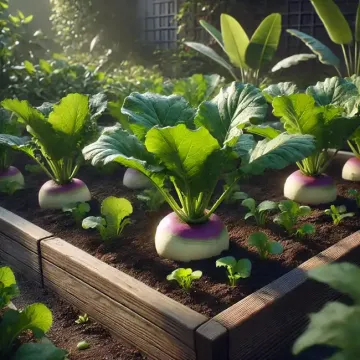Turnips are a versatile and easy-to-grow root vegetable that can be a valuable addition to your home garden. Known for their slightly spicy flavor and crisp texture, turnips offer both culinary and nutritional benefits. Whether you're growing them for their roots or leafy greens, turnips are relatively low-maintenance and thrive in various climates. Here's a guide to growing turnips in your home garden.
History of Turnips
Turnips (Brassica rapa) have been cultivated for thousands of years and are believed to have originated in the Mediterranean region. They were a staple crop in ancient Roman and Greek diets, valued for their storage ability and hardiness. Throughout history, turnips have been used as a food source for both humans and livestock, particularly during the colder months when other crops were scarce.
Health Benefits
Turnips are rich in vitamins and minerals, making them a nutritious choice for your diet. They are particularly high in vitamin C, which supports immune function and skin health, and vitamin K, which is essential for bone health. Turnip greens are also a good source of calcium, fiber, and antioxidants, which contribute to heart health and digestion. Additionally, turnips are low in calories, making them an excellent choice for weight management.
Culinary Uses
Turnips can be used in a variety of dishes, adding flavor and texture to soups, stews, and roasted vegetable medleys. They can be boiled, mashed, roasted, or eaten raw in salads. The young, tender greens are often used in salads, sautés, or as a cooked green side dish. In traditional cuisines, turnips are often paired with root vegetables like potatoes and carrots, or used as a substitute for potatoes in low-carb diets.
Growing Turnips in Your Garden
Turnips are cool-weather crops that thrive in spring and fall. They grow best in loose, well-drained soil with a pH between 6.0 and 7.5. Turnips are relatively fast-growing and can be harvested within 30 to 60 days, depending on the variety.
Planting:
- Sowing Seeds: Direct sow turnip seeds in your garden about 1/2 inch deep and 2 inches apart. Thin seedlings to 4-6 inches apart once they have sprouted.
- Timing: Plant turnips in early spring for a spring crop, or in late summer for a fall harvest. In mild climates, turnips can also be grown during the winter months.
- Sunlight: Turnips prefer full sun but can tolerate partial shade. Ensure they receive at least 4-6 hours of sunlight daily for optimal growth.
Soil Preparation:
- Soil: Turnips do best in loose, well-drained soil that is rich in organic matter. Add compost to the soil before planting to improve its texture and fertility.
- Fertilization: Turnips are not heavy feeders, but they benefit from a balanced fertilizer, particularly one that is low in nitrogen to encourage root development over leafy growth.
Watering:
- Watering Needs: Keep the soil consistently moist but not waterlogged. Turnips need about 1 inch of water per week. Mulching around the plants can help retain moisture and suppress weeds.
Pest and Disease Control:
- Common Pests: Turnips can be susceptible to pests such as flea beetles, aphids, and cabbage worms. Floating row covers can help protect young plants from these pests.
- Diseases: Turnips can suffer from diseases like clubroot and downy mildew. Practice crop rotation and avoid planting turnips in areas where other brassicas have been grown recently to reduce the risk of disease.
Harvesting Turnips
- When to Harvest: Turnip roots are typically ready for harvest when they reach 2-3 inches in diameter. For a milder flavor, harvest them when they are young and tender. Larger turnips can develop a stronger, more pungent taste.
- Harvesting Greens: Turnip greens can be harvested when they are young and tender. You can harvest the outer leaves as needed, allowing the plant to continue growing.
Storing Turnips
- Root Storage: After harvesting, turnips can be stored in a cool, dry place for several weeks. If you plan to store them for an extended period, remove the greens to prevent the roots from wilting.
- Freezing: Turnips can also be blanched and frozen for later use. This method preserves their flavor and nutritional content for several months.
Popular Varieties
- Purple Top White Globe: One of the most common turnip varieties, known for its large, round roots with a purple top and white flesh.
- Tokyo Cross: A fast-maturing, small white turnip that is excellent for early spring or fall harvests.
- Golden Ball: This variety produces sweet, golden-yellow roots that are perfect for roasting.
- Hakurei: A Japanese variety known for its mild, sweet flavor and crisp texture, ideal for eating raw or lightly cooked.
Conclusion
Growing turnips in your home garden can be a rewarding experience, providing a nutritious and versatile crop that is easy to cultivate. Whether you’re growing them for their roots or their leafy greens, turnips are a resilient vegetable that can thrive in various climates and soil conditions. With proper care and attention, your turnip harvest will be a delicious and nutritious addition to your kitchen.

